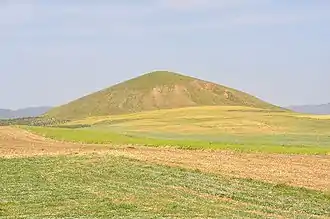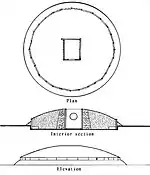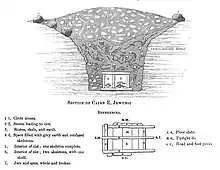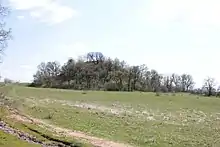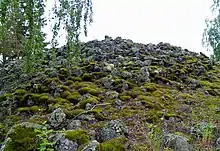Tumulus
A tumulus (plural tumuli) is a mound of earth and stones raised over a grave or graves. Tumuli are also known as barrows, burial mounds or (in Siberia and Central Asia) kurgans, and may be found throughout much of the world. A cairn, which is a mound of stones built for various purposes, may also originally have been a tumulus.


Tumuli are often categorised according to their external apparent shape. In this respect, a long barrow is a long tumulus, usually constructed on top of several burials, such as passage graves. A round barrow is a round tumulus, also commonly constructed on top of burials. The internal structure and architecture of both long and round barrows have a broad range; the categorization only refers to the external apparent shape.
The method of inhumation may involve a dolmen, a cist, a mortuary enclosure, a mortuary house, or a chamber tomb. Examples of barrows include Duggleby Howe and Maeshowe.
Etymology
The word tumulus is Latin for 'mound' or 'small hill', which is derived from the Proto-Indo-European root *teuh2- with extended zero grade *tum-, 'to bulge, swell' also found in tomb, tumor, tumescent, thumb, thigh, and thousand.[4]
Burial accounts
The funeral of Patroclus is described in book 23 of Homer's Iliad. Patroclus is burned on a pyre, and his bones are collected into a golden urn in two layers of fat. The barrow is built on the location of the pyre. Achilles then sponsors funeral games, consisting of a chariot race, boxing, wrestling, running, a duel between two champions to the first blood, discus throwing, archery and spear throwing.
Beowulf's body in the Anglo-Saxon poem Beowulf is taken to Hronesness, where it is burned on a funeral pyre. During cremation, the Geats lament the death of their lord, a widow's lament being mentioned in particular, singing dirges as they circumambulate the barrow. Afterwards, a mound is built on top of a hill, overlooking the sea, and filled with treasure. A band of twelve of the best warriors ride around the barrow, singing dirges in praise of their lord.
Parallels have also been drawn to the account of Attila's burial in Jordanes' Getica.[5] Jordanes tells that as Attila's body was lying in state, the best horsemen of the Huns circled it, as in circus games.
An Old Irish Life of Columcille reports that every funeral procession "halted at a mound called Eala, whereupon the corpse was laid, and the mourners marched thrice solemnly round the spot."
Types
Archaeologists often classify tumuli according to their location, form, and date of construction (see also mound). Some British types are listed below:
- Bank barrow
- Bell barrow
- Bowl barrow
- D-shaped barrow – round barrow with a purposely flat edge at one side often defined by stone slabs.
- Disc barrow
- Fancy barrow – generic term for any Bronze Age barrows more elaborate than a simple hemispherical shape.
- Long barrow
- Oval barrow – a Neolithic long barrow consisting of an elliptical, rather than rectangular or trapezoidal mound.
- Platform barrow – The least common of the recognised types of round barrow, consisting of a flat, wide circular mound that may be surrounded by a ditch. They occur widely across southern England with a marked concentration in East and West Sussex.
- Pond barrow – a barrow consisting of a shallow circular depression, surrounded by a bank running around the rim of the depression, from the Bronze Age.
- Ring barrow – a bank that encircles a number of burials.
- Round barrow – a circular feature created by the Bronze Age peoples of Britain and also the later Romans, Vikings, and Saxons. Divided into subclasses such as saucer and bell barrow – the Six Hills are a rare Roman example.
- Saucer barrow – a circular Bronze Age barrow that features a low, wide mound surrounded by a ditch that may have an external bank.
- Square barrow – burial site, usually of Iron Age date, consisting of a small, square, ditched enclosure surrounding a central burial, which may also have been covered by a mound.
Modern practices

There is a contemporary revival in barrow building in the UK.[6] In 2015 the first long barrow in thousands of years, the Long Barrow at All Cannings, inspired by those built in the Neolithic era, was built on land just outside the village of All Cannings.[7] The barrow was designed to have a large number of private niches within the stone and earth structure to receive cremation urns.
This was followed by new barrows at:
- The Willow Row Barrow at St Neots.[8]
- The Soulton Long Barrow at Soulton in Shropshire.[9][10][11][12][13]
- Higher Ground Meadow in Dorset[14]
- Warwickshire.[15]
Plans have also been announced for a barrow in Milton Keynes[16] and in Powys.[17]
Sites
Horn of Africa
Salweyn in Somaliland contains a very large field of cairns, which stretches for a distance of around 8 km.[18] An excavation of one of these tumuli by Georges Révoil in 1881 uncovered a tomb, beside which were artefacts pointing to an ancient, advanced civilization. The interred objects included pottery shards from Samos, some well-crafted enamels, and a mask of Ancient Greek design.[19]
The Sahel
Preceded by assumed earlier sites in the Eastern Sahara, tumuli with megalithic monuments developed as early as 4700 BC in the Saharan region of Niger.[20] Fekri Hassan (2002) indicates that the megalithic monuments in the Saharan region of Niger and the Eastern Sahara may have served as antecedents for the mastabas and pyramids of ancient Egypt.[20]
The prehistoric tradition of monarchic tumuli-building is shared by both the West African Sahel and the Middle Nile regions.[21] Ancient Egyptian pyramids of the early dynastic period and Meroitic Kush pyramids are recognized by Faraji (2022) as part of and derived from an earlier architectural "Sudanic-Sahelian" tradition of monarchic tumuli, which are characterized as "earthen pyramids" or "proto-pyramids."[21] Faraji (2022) characterized Nobadia as the "last pharaonic culture of the Nile Valley" and described mound tumuli as being "the first architectural symbol of the sovereign's return and reunification with the primordial mound upon his death."[21] Faraji (2022) indicates that there may have been a cultural expectation of "postmortem resurrection" associated with tumuli in the funerary traditions of the West African Sahel (e.g., northern Ghana, northern Nigeria, Mali) and Nile Valley (e.g., Ballana, Qustul, Kerma, Kush).[21] Based on artifacts found in the tumuli from West Africa and Nubia, there may have been "a highly developed corporate ritual in which the family members of the deceased brought various items as offerings and tribute to the ancestors" buried in the tumuli and the tumuli may have "served as immense shrines of spiritual power for the populace to ritualize and remember their connection to the ancestral lineage as consecrated in the royal tomb."[21] Between the 8th millennia BCE and the 4th millennia BCE, riverine farmers and savanna herders traversed the interconnected region of the Middle Nile Valley.[21] In the Saharan-Sahelian and Middle Nile Valley regions, dotted wavy line and wavy line pottery, which was produced between the 8th millennia BCE and the 4th millennia BCE (late Neolithic and early Bronze Age), preceded the emergence of monarchic tumuli; the spread of the pottery spanned from the savanna region to the eastern Saharan region, and from Mauritania to the Red Sea, which supports the conclusions of trade between the regions and their interconnectedness.[21] Wavy-line pottery developed six ceramic subvariants and dotted wavy-line pottery developed three ceramic subvariants; the locations for the earliest development of both 8th millennium BCE potteries were at Sagai and Sarurab in Sudan.[21] Wavy-line pottery spread throughout multiple locations (e.g., mostly in Central Nile; some in Hoggar Mountains, southern Algeria, Delibo Cave, Chad, Jebel Eghei, Chad, Tibesti, Chad, and Adrar Madet, Niger) in Africa.[21] Dotted wavy-line pottery spread throughout multiple locations (e.g., Ennedi Plateau, Niger Plateau, and Wadi Howar of Saharan-Sahelian region, interconnecting the regions of the Middle Nile River, Lake Chad, and Benue-Niger River) in Africa as well.[21] Both potteries also spread along a north-to-west regional axis (e.g., Wadi Howar, Ennedi Plateau, Chad, Jebel Uweinat, Gilf Kebir, Egypt) near the Saharan regions of Sudan and Egypt.[21] The tumuli from the kingdom of Kerma serve as a regional intermediary between the regions of the Nile River and the Niger River.[21]
The "Classical Sudanese" monarchic tumuli-building tradition, which lasted in Sudan (e.g., Kerma, Makuria, Meroe, Napata, Nobadia) until the early period of the 6th century CE as well as in West Africa and Central Africa until the 14th century CE, notably preceded the spread of Islam into the West African and Sahelian regions of Africa.[21] According to al-Bakrī, "the construction of tumuli and the accompanying rituals was a religious endeavor that emanated from the other elements" that he described, such as "sorcerers, sacred groves, idols, offerings to the dead, and the "tombs of their kings.""[21] Faraji (2022) indicated that the early dynastic period of ancient Egypt, Kerma of Kush, and the Nobadian culture of Ballana were similar to al-Bakrī's descriptions of the Mande tumuli practices of ancient Ghana.[21] A characteristic of divine kingship sometimes includes monarchic funerary practices (e.g., Ancient Egyptian funerary practices).[21] In the lake region of Niger, two human burial sites included funerary rooms with graves that contain various bones (e.g., human, animal) and items (e.g., beads, ornaments, weapons).[21] In the Inland Niger Delta, 11th century CE and 15th century CE tumuli at El Oualedji and Koï Gourrey contained various bones (e.g., human, horse), human items (e.g., beads, bracelets, rings), and animal items (e.g., bells, harnesses, plaques).[21] Cultural similarities were also found with a Malinke king of Gambia, who along with his senior queen, human subjects within his kingdom, and his weapons, were buried in his home under a large mound the size of the house, as described by V. Fernandes.[21] Levtzion also acknowledged the cultural similarities between the monarchic tumuli-building traditions and practices (e.g., monumental Senegambian megaliths) of West Africa, such as Senegambia, Inland Niger Delta, and Mali, and the Nile Valley; these monarchic tumuli-building practices span the Sudanian savanna as manifestations of a trans-Sahelian common culture and heritage.[21] From the 5th millennium BCE to the 14th century CE, earthen and stone tumuli were developed between Senegambia and Chad.[21] Among 10,000 burial mounds in Senegambia, 3,000 megalithic burial mounds in Senegambia were constructed between 200 BCE and 100 CE, and 7,000 earthen burial mounds in Senegal were constructed in the 2nd millennium CE.[21] Between 1st century CE and 15th century CE, megalithic monuments without tumuli were constructed.[21] Megalithic and earthen Senegambian tumuli, which may have been constructed by the Wolof people (Serer people) or Sosse people (Mande peoples).[21] Sudanese tumuli (e.g., Kerma, C-Group), which date to the mid-3rd millennium BCE, share cultural similarities with Senegambian tumuli.[21] Between the 6th century CE and 14th century CE, stone tumuli circles, which at a single site usually encircle a burial site of half-meter that is covered by a burial mound, were constructed in Komaland; the precursors for this 3rd millennium BCE tumuli style of Komaland, Ghana and Senegambia are regarded by Faraji (2022) to be Kerma Kush and the A-Group culture of ancient Nubia.[21] While the stele-circled burial mounds of C-Group culture of Nubia are regarded as precursors for the megalithic burial mounds of Senegambia, Kerma tumuli are regarded as precursors for the stone tumuli circles of Komaland.[21] Based on a founding narrative of the Hausa people, Faraji (2022) concludes the possibility of the "pre-Islamic rulers of Hausaland" being a "dynasty of female monarchs reminiscent of the kandake of Meroitic Kush."[21] The tumuli of Durbi Takusheyi, which have been dated between the 13th century CE and the 16th century CE, may have connection to tumuli from Ballana and Makuria.[21] Tumuli have also been found at Kissi, in Burkina Faso, and at Daima, in Nigeria.[21]
In Niger, there are two monumental tumuli – a cairn burial (5695 BP – 5101 BP) at Adrar Bous, and a tumulus covered with gravel (6229 BP – 4933 BP) at Iwelen, in the Aïr Mountains.[22] Tenerians did not construct the two monumental tumuli at Adrar Bous and Iwelen.[22] Rather, Tenerians constructed cattle tumuli at a time before the two monumental tumuli were constructed.[22]
The Tichitt Tradition of eastern Mauritania dates from 2200 BC[23][24] to 200 BC.[25][26] Within the settled areas of Tichitt Culture (e.g., Dhar Tichitt, Dhar Tagant, Dhar Walata), with stone walls, which vary in scale from (e.g., 2 hectares, 80 hectares), there were walled agricultural land utilized for livestock or gardening as well as land with granaries and tumuli.[26] Based on the hundreds of tumuli present in Dhar Tichitt, compared to a dozen tumuli present in Dhar Walata, it is likely that Dhar Tichitt was the primary center of religion for the people of Tichitt culture.[27]
At Wanar, Senegal, megalithic monolith-circles and tumuli (1300/1100 BC – 1400/1500 AD) were constructed by West Africans who had a complex hierarchical society.[28] In the mid-region of the Senegal River Valley, the Serer people may have created tumuli (before 13th century AD), shell middens (7th century AD – 13th century AD) in the central-west region, and shell middens (200 BC – Present) in the southern region.[29] The funerary tumuli-building tradition of West Africa was widespread and a regular practice amid 1st millennium AD.[30] More than ten thousand large funerary tumuli exist in Senegal.[30]
At the Inner Niger Delta, in the Mali Lakes Region, there are two monumental tumuli constructed in the time period of the Trans-Saharan trade for the Sahelian kingdoms of West Africa.[31] The El Oualadji monumental tumulus, which dates between 1030 AD and 1220 AD and has two human remains buried with horse remains and various items (e.g., horse harnesses, horse trappings with plaques and bells, bracelets, rings, beads, iron items), may have been, as highlighted by al-Bakri, the royal burial site of a king from the Ghana Empire.[31] The Koï Gourrey monumental tumulus, which may date prior to 1326 AD and has over twenty human remains that were buried with various items (e.g., iron accessories, an abundant amount of copper bracelets, anklets and beads, an abundant amount of broken, but whole pottery, another set of distinct, intact, glazed pottery, a wooden-beaded bone necklace, a bird figurine, a lizard figurine, a crocodile figurine), and is situated within the Mali Empire.[31]
Central Asia
The word kurgan is of Turkic origin, and derives from Proto-Turkic *Kur- ("to erect (a building), to establish"). In Ukraine and Russia, there are royal kurgans of Varangian chieftains, such as the Black Grave in Ukrainian Chernihiv (excavated in the 19th century), Oleg's Grave in Russian Staraya Ladoga, and vast, intricate Rurik's Hill near Russian Novgorod. Other important kurgans are found in Ukraine and South Russia and are associated with much more ancient steppe peoples, notably the Scythians (e.g., Chortomlyk, Pazyryk) and early Indo-Europeans (e.g., Ipatovo kurgan) The steppe cultures found in Ukraine and South Russia naturally continue into Central Asia, in particular Kazakhstan.
It is constructed over a grave, often characterized by containing a single human body along with grave vessels, weapons and horses. Originally in use on the Pontic–Caspian steppe, kurgans spread into much of Central Asia and Eastern, Southeast, Western and Northern Europe during the 3rd millennium BC.[32]
The earliest kurgans date to the 4th millennium BC in the Caucasus,[33] and researchers associate these with the Indo-Europeans.[34] Kurgans were built in the Eneolithic, Bronze, Iron, Antiquity and Middle Ages, with ancient traditions still active in Southern Siberia and Central Asia.
Turkey
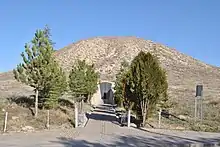
On the Anatolian peninsula, there are several sites where one can find the biggest specimens of these artificial mounds throughout the world. Three of these sites are especially important. Bin Tepe (and other Lydian mounds of the Aegean inland), Phrygian mounds in Gordium (Central Anatolia), and the famous Commagene tumulus on Mount Nemrut (Southeastern Anatolia).
This is the most important of the enumerated sites with the number of specimens it has and with the dimensions of certain among them. It is in the Aegean inland of Turkey. The site is called "Bin Tepeler" (a thousand mounds in Turkish) and it is in the northwest of Salihli district of Manisa province. The site is very close to the southern shoreline of Lake Marmara (Lake Gyges or Gygaea). Bin Tepeler is a Lydian necropolis that dates back to 7th and 6th centuries BC. These mounds are called "the pyramids of Anatolia", as a giant specimen among them is 355 metres in diameter, 1115 metres in perimeter and 69 metres high. According to Herodotus, this giant tumulus belongs to the famous Lydian King Alyattes who ruled between 619 and 560 BC. There is also another mound belonging to King Gyges. The Gyges mound was excavated but the burial chamber hasn't been found yet. On this site, there are 75 tumuli dating back to Lydian period that belong to the nobility. A large number of smaller artificial mounds can also be observed on the site. There are other Lydian tumuli sites around Eşme district of Uşak province. Certain mounds on these sites had been plundered by raiders in the late 1960s, and the Lydian treasures found in their burial chambers were smuggled to the United States, which later returned them to Turkish authorities after negotiations. These artifacts are now exhibited in the Archaeological Museum of Uşak.

Gordium (Gordion) was the capital of the ancient kingdom of Phrygia. Its ruins are in the immediate vicinity of Polatlı, near the Turkish capital Ankara. At this site, approximately 80–90 tumuli date back to the Phrygian, Persian and Hellenistic periods. Around 35 tumuli have been excavated so far, ranging in date from the 8th century BC to the 3rd or 2nd century BC. The biggest tumulus at the site is believed to have covered the burial of the famous Phrygian King Midas or that of his father. This mound, called Tumulus MM (for "Midas Mound"), was excavated in 1957 by a team from the University of Pennsylvania Museum, led by Rodney Young and his graduate students. Among the many fine bronze artifacts recovered from the wooden burial chamber were 170 bronze vessels, including numerous "omphalos bowls", and more than 180 bronze "Phrygian fibulae" (ancient safety pins). The wooden furniture found in the tomb is especially noteworthy, as wood seldom survives from archaeological contexts: the collection included nine tables, one of them elaborately carved and inlaid, and two ceremonial serving stands inlaid with religious symbols and geometric patterns. Important bronze and wooden artifacts were also found in other tumulus burials at the site.
Mount Nemrut is 86 km in the east of Adıyaman province of Turkey. It is very close to Kahta district of the same province. The mountain has, at its peak, 3050 metres of height above sea level. A tumulus that dates to the 1st century BC is at the peak of the mountain. This artificial mound has 150 metres in diameter and a height of 50 metres, which was originally 55 metres. It belongs to the Commagene King Antiochus I Theos of Commagene who ruled between 69 and 40 BC. This tumulus is made of broken stone pieces, which renders excavation attempts almost impossible. The tumulus is surrounded by ceremonial terraces in the east, west, and north. The east and west terraces have tremendous statues (reaching 8 to 10 meters in height) and bas reliefs of gods and goddesses from the Commagene pantheon where divine figures used to embody the Persian and Roman perceptions together.
Bahrain
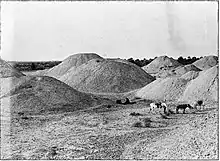
The Dilmun Burial Mounds comprising necropolis areas on the main island of Bahrain dating back to the Dilmun civilization and the Umm al-Nar culture.[35]
Each of the tumuli is composed of a central stone chamber that is enclosed by a low ring-wall and covered by earth and gravel. The size of the mounds varies, but the majority of them measure 15 by 30 ft (4.5 by 9 m) in diameter and are 3–6 ft (1–2 m) high. The smaller mounds usually contain only one chamber. The chambers are usually rectangular with one or two alcoves at the northeast end. Occasionally there are additional pairs of alcoves along the middle of the larger chambers.[36]
Although the chambers usually contained one burial each, some contain several people and the secondary chambers often contain none. The deceased were generally laid with their heads in the alcove end of the chamber and lying on their right sides. The bodies were accompanied by few items. There were a few pieces of pottery and occasionally shell or stone stamp seals, baskets sealed with asphalt, ivory objects, stone jars, and copper weapons. The skeletons are representative of both sexes with a life expectancy of approximately 40 years. Babies were generally buried at and outside the ring-wall. The average number of children per family was 1.6 persons.[36]
Israel

A tumulus forms the center of the ancient megalithic structure of Rujm el-Hiri in the Golan Heights. Rujm in Arabic can mean tumulus, cairn or stone heap. Near the western city limits of modern Jerusalem, 19 tumuli have been documented (Amiran, 1958). Though first noticed in the 1870s by early surveyors, the first one to be formally documented was Tumulus #2 in 1923 by William Foxwell Albright, and the most recent one (Tumulus #4) was excavated by Gabriel Barkay in 1983. The association of these tumuli with the Judean kings who ruled Jerusalem does not substantiate Biblical history since it is mere speculation. No inscriptions naming any specific Judean king have been excavated from a tumulus.
- More than half of these ancient Israeli structures have now been threatened or obliterated by modern construction projects, including Tumulus #4, which was excavated hastily in a salvage operation. The most noteworthy finds from this dig were two LMLK seal impressions and two other handles with associated Concentric Circle incisions, all of which suggests this tumulus belonged to either King Hezekiah[37] or his son Manasseh.[38]
- When comparing the number of these tumuli to the total number of Israelite kings (northern and southern), note that Saul never ruled in Jerusalem, and Athaliah was never crowned. She took the throne by force (2Kings 11:1–3), and would certainly not have been honored with a tumulus ceremony following her brutal assassination.
- The northern kings did not reign over the southern kingdom, and they would certainly not have been honored with a tumulus ceremony in Jerusalem; if any ceremonies were held for them, they would have transpired in the north (near Bethel, Tirzah, or Samaria).
South Asia
India
Round mound burials are associated with megalithic burials in India.[39] Most megalithic mounds with chambers found today have been disturbed over centuries and their original form was badly disturbed. Examination of other lesser disturbed monuments shows that the chamber was surrounded by a packing of earth, chipped rubble blocks and covered on the outside with inclined stone slabs whose top ends rested on the periphery of the capstone creating a mound.[40] These pre-historic megalithic mound burials with chambers likely influenced later devolvement of mound burials called "Stupa" mounds, Similarities of the stupa with early megalithic mounds are noted with structural and functional features of the stupa (including its general mound shape and the practice of surrounding stupas with a stone, relic chamber, or wooden railing) with both pre-Mauryan era cairns and pre-historic megalithic "round mound" burials with chambers found in India, which likely represents a "proto-stupa".[41]
In Dholavira, an archeological site associated with Indus Valley Civilization, there are several large and high "hemispherical monuments" mounds with brick masonry found with burial chambers inside. Among them, Tumulus-1 and Tumulus-2 mounds were excavated. They consist of a deep and wide rock-cut chamber, surrounded on the ground by a massive circular mud-brick structure made in two tiers, and filled in and topped with random earth to form a domical shape.[42] There is also evidence of plastering on the exterior of Tumulus-1 mound, bearing a 10- mm thick plaster of pinkish-white clay over brick masonry.[42] The offering in Tumulus-1 consisted of one full necklace of steatite stringed in a copper wire with hooks for interlocking, solid gold bangle with incurved ends, ageta and gold beads, along with a considerable assemblage of pottery.[42]
Another type of mound burial is Maidam in Assam, India. The Ahom kingdom in medieval Assam built octagonal-shaped tumuli called Maidams for their kings and high officials. The kings were buried in a hillock at Charaideo in Sibsagar district of Assam, whereas other Maidams are found scattered more widely.[43]
Pakistan
The damb was a type of mound, or small stone structure, found in Balochistan, including the coastal areas of Makran.
China
The Chinese pyramids house the remains of some of China's former emperors.
Before the expansion of Shang and Zhou culture through the region, many hundreds of tumuli were also constructed by the "Baiyue" peoples of the Yangtze Valley and southeastern China.
Japan


In Japan, powerful leaders built tumuli known as kofun. The Kofun period of Japanese history takes its name from these burial mounds.[44] The largest is Daisen-ryo Kofun, or more commonly Nintoku-ryo Kofun, with a length of 840 metres. In addition to other shapes, kofun includes a keyhole shape, typically seen in Daisen Kofun. Foreign museums possess some grave goods.
Korea

see also Cheonmachong, the Heavenly Horse Tomb
The first burial mounds in Korea were dolmens, which contained material from cultures of the 1st millennium AD, such as bronze-ware, pottery, and other symbols of the society elite. The most famous tumuli in Korea, dating around 300 AD, are those left behind by the Korean Baekje, Goguryeo (Kogyuro/Koguryo), Silla, and Gaya states and are clustered around ancient capital cities in modern-day Pyongyang, Ji'an, Jilin, Seoul, and Gyeongju. The Goguryeo tombs, shaped like pyramids, are famous for the well-preserved wall murals like the ones at Anak Tomb No.3, which depict the culture and artistry of the people. The base of the tomb of King Gwanggaeto is 85 meters on each side, half of the size of the Great Pyramids.[45] Goguryeo Silla tombs are most noted for the fabulous offerings that have been excavated such as delicate golden crowns and glassware and beads that probably made their way to Korea via the Silk Road. Many indigenous Korean artifacts and culture were transmitted to the tomb builders of early Japan, such as horse-trappings, bronze mirrors, paintings and iron-ware.
Albania
Tumuli are one of the most prominent types of prehistoric monuments spread throughout northern and southern Albania. Some well-known local tumuli are:
- Kamenica Tumulus
- Lofkënd Tumulus
- Pazhok Tumulus
Bosnia and Herzegovina
More than 50 burial mounds were found in Kupres. Man from Kupres – the skeleton found in one of the tumuli is believed to be more than 3000 years old and it is kept in Gorica museum in Livno. Glasinac has many tumuli. During the Bronze and Iron Age it was a place of strong Glasinac culture, who buried their dead in tumulus.
Bulgaria

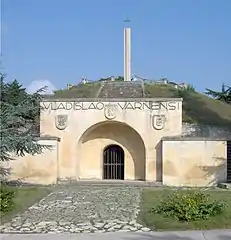
On the territory of Bulgaria there are over 60,000 ancient Thracian mounds, of which only about 1,000 have been studied. There are also Roman and Thraco-Roman burial tombs. Those tumuli over ancient tombs, temples and sanctuaries are found throughout the whole territory of Bulgaria. Some of the world's most significant and famous being the Kazanlak and Sveshtari tombs, UNESCO World Heritage sites. Located near the ancient Thracian capital cities of Seuthopolis (of the Odrysian kingdom) and Daosdava or Helis (of the Getae), perhaps they represented royal burials. Other notable tumuli are the Thracian tomb of Aleksandrovo, Thracian tomb Golyama Arsenalka, Thracian tomb Shushmanets, Thracian tomb Griffins, Thracian tomb Helvetia, Thracian tomb Ostrusha, Tomb of Seuthes III and the other tombs around Starosel, others contained offerings such as the Panagyurishte and Rogozen treasures. Some of the sites are located in the Valley of the Thracian Rulers. The mound of the Tomb of Seuthes III "Golyama Kosmatka" is among the largest mounds in Thrace, with a maximum height of 23 m. and a diameter of 130 m.
Croatia
There are thousands of tumuli throughout all Croatia, built of stone (Croatian: gomila, gromila) in the karst areas (by the Adriatic Sea) or made of earth (Croatian: humak) in the inland plains and hills. Most of these prehistoric structures were built in the 2nd and 1st millennium BC, from the middle Bronze Age to the end of the Iron Age, by the Illyrians or their direct ancestors in the same place; the Liburnian inhumation of dead under tumuli was certainly inherited from the earlier times, as early as the Copper Age. Smaller tumuli were used as the burial mounds, while bigger (some up to 7 metres high with 60 metres long base) were the cenotaphs (empty tombs) and ritual places.[46]
Greece
Some of the world's most prominent Tumuli, the Macedonian tombs and a cist-grave at Vergina include the tomb of Philip II (359–336 BC), father of Alexander the Great (336–323 BC), as well as the tomb of Alexander IV (323–309 BC), son of Alexander the Great. A very large tumulus has been discovered in Amphipolis. Known as the Kasta Tomb, the tomb's occupant is presently unknown. Also numerous Mycenaean Greek Tombs are in all essence Tumuli, notably Agamemnon's site in Mycenae, and other sites in Tiryns, near Olympia and Pylos, and mostly in the Peloponnese peninsula near Mycenaean sites and Bronze Age settlements. Moreover, in Central Greece there are numerous Tumuli, some excavated, others not. A notable one is in Marathon, serving as a burial for the ones who fell during battle.
As of October 2014 there are ongoing excavations at the Kasta Tomb in Amphipolis, Macedonia, Greece with the tumulus having a perimeter of 497 meters. The tomb within is assessed to be an ancient Macedonian burial monument of the last quarter of the 4th century BC.
Hungary
There are over 40,000 tumuli in the Great Hungarian Plain, the highest is Gödény-halom near the settlement of Békésszentandrás, in Békés county.[47]
Sírhalom origins and forms are diverse: tells, graves, border barrows, watcher barrows.[48]
Serbia
- Mrčajevci, several prehistoric tumuli
- Bukovac, Illyrian tumuli and necropolis
- Five prehistoric tumuli in the Morava valley.
- Gromile, Serbian tumuli in Ravna Gora.[49]
- Kinđa
Austria
.JPG.webp)
- Burgstallkogel (Sulm valley)
- Großmugl (Lower Austria)
- Pillichsdorf (Lower Austria)
- Niederhollabrunn (Lower Austria)
- Gaisruck[50] (in Niederösterreich)
- Langenlebarn[51] (in Niederösterreich)
- Deutsch-Altenburg[52] (in Niederösterreich)
- Bernhardsthal[53] (Lower Austria)
- Siegendorf (Burgenland)
- Schandorf[54] (Burgenland)
- Kleinklein[55] (Styria)
- Niederfellabrunn (Lower Austria))
- Oberhofen am Irrsee (Upper Austria)
- Obermallebarn (Lower Austria)
- Unterzögersdorf (Lower Austria)
Belgium
- Two Tumuli of Ambresin (Liège Province)
- Tumulus of Avernas in Hannut (Liège): height: 8 m; circumference: 100 m
- Tumulus of the "champ de la Tombe" in Braives (Liège), 1st century AD Roman tomb.
- Tumulus of Court-Saint-Étienne (Walloon Brabant), around 3,000 BC.
- Tumulus of Glimes in Incourt (Walloon Brabant), Gallo-Roman period: height: 11 m; diameter: 50 m
- Tumulus of Hottomont in Ramillies (Walloon Brabant), tomb of : height: 11.5 m; diameter: 50 m
- Tumulus of Oleye (Liek) (Liège)[56]
- Tumulus of Pepin of Landen in Landen (Flemish Brabant)
- Tumuli of the Sonian Forest (Flemish Brabant), 1st millennium BC.
- Three Tumuli of Grimde in Tienen (Flemish Brabant), 1st century BC Gallo-Roman tombs.[57]
- Tumulus of Trou de Billemont in Antoing (Hainaut Province), 6th and 7th-century Merovingian tombs.
- Tumulus of Walhain (Walloon Brabant)
- Two Tumuli of Waremme (Liège)
- Tumuli of Wéris (Belgian Luxembourg), 4th and 3rd millennium BC.
United Kingdom

In the United Kingdom, barrows of a wide range of types were in widespread use for burying the dead from the late Neolithic until the end of the Bronze Age, 2900–800 BC. Square barrows were occasionally used in the Iron Age (800 BC-43 AD) in the east of England. The traditional round barrow experienced a brief resurgence following the Anglo-Saxon conquests, with the introduction of northern Germanic burial practices from continental Europe. These later barrows were often built near older Bronze Age barrows. They included a few instances of ship burial. Barrow burial fell out of use during the 7th century as a result of the spread of Christianity. Early scholarly investigation of tumuli and theorising as to their origins was undertaken from the 17th century by antiquaries, notably John Aubrey, and William Stukeley. During the 19th century in England the excavation of tumuli was a popular pastime amongst the educated and wealthy upper classes, who became known as "barrow-diggers". This leisure activity played a key role in laying the foundations for the scientific study of the past in Britain but also resulted in untold damage to the sites.
Notable British barrows include:
- West Kennet Long Barrow – Neolithic long barrow in Wiltshire
- Wayland's Smithy – Neolithic long barrow and chamber tomb in Oxfordshire (historically Berkshire)
- Belas Knap – Neolithic long barrow in Gloucestershire
- Maeshowe – Neolithic chambered cairn and passage grave on Mainland, Orkney
- Duggleby Howe – Neolithic round barrow in the East Riding of Yorkshire
- Sutton Hoo – 7th-century East Anglian ship burial with exceptionally rich grave goods in Suffolk
- Devil's Humps – Bronze Age barrow group on Bow Hill in West Sussex
- Devil's Jumps – Bronze Age barrow group on the South Downs of West Sussex
- Seamer Beacon – Bronze Age barrow near Scarborough, North Yorkshire
Czech Republic
During the early Middle Ages, Slavic tribesmen inhabiting what is now the Czech Republic used to bury their dead under barrows. This practice has been widespread in southern and eastern Bohemia and some neighbouring regions, like Upper Austria and Lusatia, which at that time have been also populated with Slavic people. There are no known Slavic barrows in the central part of the country (around Prague), nor are they found in Moravia. This has led some of the archaeologists to speculations about at least three distinct waves of Slavic settlers, who colonized Czech lands separately from each other, each wave bringing its customs with it (including burial rituals).
At places where barrows have been constructed, they are usually found in groups (10 to 100 together), often forming several clearly distinct lines going from the west to the east. Only a few of them have been studied scientifically so far; in them, both burials by fire (with burnt ashes) and unburned skeletons have been found, even on the same site. It seems that builders of the barrows have at some time switched from burials by fire to burying of unburned corpses; the reason for such change is unknown. The barrows date too far back in history (700 AD to 800 AD) to contain any Christian influences.

As Czech barrows usually served for burials of poor villagers, only a few objects are found in them except for cheap pottery. Only one Slavic barrow is known to have contained gold.
Most of the Czech burial barrows have been damaged or destroyed by intense agriculture in the densely populated region. Those that remain are usually in forests, especially at hilltops in remote places. Therefore, there is no general knowledge about burial barrows among Czech population.
The best Slavic barrow sites can be found near to Vitín, a small village close to České Budějovice. There are two groups of barrows close to Vitín, each containing about 80 barrows ordered in lines. Some of the barrows are as much as 2 metres high.
There are also some prehistoric burial barrows in Czech Republic, built by unknown people. Unlike Slavic barrows, they can be found all across the country, though they are scarce. Distinguishing them from Slavic ones is not an easy task for the unskilled eye. Perhaps the most famous of them forms the top of the Žuráň hill near Slavkov u Brna; it is from here that Napoleon commanded his forces during the Battle of Austerlitz.
France
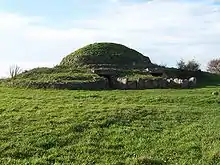
- Bougon (Deux-Sèvres) tumuli are a set of five tumuli all at one site: the building and using took place over a long period from 4,500 to 3,000 BC. This set is considered to be one of the oldest western European megalithic necropolis.[58]
- The Bussy-le-Château commune (Marne) has five Roman, Visigoth and Burgundian tumuli: three of them remain relatively intact along the Noblette river.[59]
- The neolithic Saint-Michel de Carnac tumulus in Carnac was built between 5,000 and 3,400 BC.
- A few kilometers from Carnac are the 140 by 20 metres (459 ft × 66 ft) neolithic Er-Grah tumuli near the famous broken Menhir.[60]
- The five Tumulus de champ Châlons in the Benon forest form a neolithic necropolis in the Courçon commune (Charente-Maritime).[61]
- Dissignac tumulus is a neolithic monument located about 5 kilometres west of Saint-Nazaire (Loire-Atlantique).[62]
- The tumulus of Lamalou dolmen is situated at the headwaters of the Lamalou river.[63]
- Tumulus and burial chamber (dolmen) of Bergerie de Panissière is located near Alès (Gard).[64]
- Tanouëdou tumulus is located near Bourbriac (Côtes d'Armor, Brittany).[65]
- Péré Tumulus on Prissé-la-Charrière commune (Deux-Sèvres): a neolithic long barrow with tumulus 100 by 20 metres (328 ft × 66 ft), dating from 4,450 to 4,000 BC.[66]
- Saint-Fiacre tumulus, on the Melrand commune (Morbihan), is listed as monument historique since 1972.[67]
- Appenwihr tumuli on the Appenwihr commune (Haut Rhin) are a set of nine small tumuli (about 1.50 metres (4.9 ft) tall and one higher at 4 to 5 metres (13 to 16 ft)), not far to the north-west. The results of the excavations are exposed in the Unterlinden Museum in Colmar.
- Tumulus des Hogues, neolithic monuments located in Habloville.[68]
Germany
Hügelgrab ("barrow", "burial mound" or "tumulus") sites in Germany dating to the Early and Middle Bronze Age.
Barrows or tumuli sites in Germany dating to the Late Bronze and Iron Age.
| Name | Place | Region | Bundesland | Type | Date | Era |
|---|---|---|---|---|---|---|
| Pöckinger Gemeindegebiet (Pöcking local community area) | Pöcking | Munich area | Bavaria | grave-hill field | c. 750–500 BC | Hallstatt culture |
| Glauberg | Glauburg | Wetteraukreis | Hesse | Kings graves | 5th century BC | Early Celtic Age |
| Lahnberge | Marburg | Landkreis Marburg-Biedenkopf | Hesse | >200 Hilly graves | c. 1600 – 5th century BC | Middle Bronze Age (Tumulus culture), Late Bronze Age (Urnfield culture), Iron Age (Hallstatt Culture) |
| Hohmichele | Hundersingen | Landkreis Sigmaringen | Baden-Württemberg | Kings graves | c. 600–450 BC | Hallstatt culture |
| Grave-hill of Hochdorf | Hochdorf an der Enz | Landkreis Ludwigsburg | Baden-Württemberg | Hilly-grave | 5th century BC | Hallstatt culture |
| Lehbühl | Schlaitdorf | Landkreis Esslingen | Baden-Württemberg | Hill-grave | c. 600–400 BC | Hallstatt culture |
| Daxberg Tumuli (Mömbris) | Daxberg (Mömbris) | Landkreis Aschaffenburg | Bavaria | Hilly-grave field | c. 2000–800 BC | Iron Age |
| Daxberg Tumuli (Erkheim) | Daxberg (Erkheim) | Landkreis Unterallgäu | Bavaria | Hilly-grave field | 8th century BC | Iron Age |
| Neu Quitzenow | Neu Quitzenow | Rostock | Mecklenburg-Vorpommern | 2 Hilly-graves | c. 1800–600 BC | |
| Royal grave of Seddin | Seddin | Landkreis Prignitz | Brandenburg | Kings graves | 8th century BC | Bronze Age |
| Pestrup Grave fields | Wildeshausen | Landkreis Oldenburg | Lower Saxony | ~ 500 grave-hills | c. 900–200 BC | Bronze Age |
| Magdalenenberg | Villingen | Schwarzwald-Baar-Kreis | Baden-Württemberg | Kings grave | c. 616 BC | Hallstatt culture |
| Wagon grave of Bell | Bell (Hunsrück) | Rhein-Hunsrück-Kreis | Rhineland-Palatinate | Wagon-grave | 500 BC | Hallstatt culture |
| Schweinert Tumuli | Falkenberg (in Schweinert Nature reserve) | Landkreis Elbe-Elster | Brandenburg | 642-hill-graves field | c. 1000 BC | |
| Breitenfeld | Neuhausen ob Eck | Landkreis Tuttlingen | Baden-Württemberg | 21 grave-hills | c. 700 BC – 450 AD | Hallstatt culture |
Barrows or tumuli sites in Germany dating to the Stone Age.
| Name | Place | Region | Bundesland | Type | Date | Era |
|---|---|---|---|---|---|---|
| Grave fields of Grabau | Grabau (Stormarn) | Kreis Stormarn | Schleswig-Holstein | 9 grave-hills | 6500–5500 BC | Young Stone Age |
| Mansenberge | Groß Berßen | Landkreis Emsland | Lower Saxony | Great stone grave | 3600–2800 BC | Megalith Culture |
Other Barrows/tumuli in Germany of unstated date.
| Name | Place | Region | Bundesland | Type | Date | Era |
|---|---|---|---|---|---|---|
| Beckdorf | Beckdorf | Landkreis Stade | Lower Saxony | Hilly-grave | ||
| Heidelberg | Wiera | Schwalm-Eder-Kreis | Hesse | Hill-grave | Bronze Age | |
| Mellingstedt | Lemsahl-Mellingstedt | Wandsbek | Hamburg | Hilly-grave | Bronze Age | |
| Höltinghausen | Höltinghausen | Landkreis Cloppenburg | Lower Saxony | Hilly-grave field | ||
| Plankenheide | Nettetal | Kreis Viersen | North Rhine-Westphalia | Hill-grave | ||
| Kranzberger Forst | Kranzberg | Landkreis Freising | Bavaria | 19 Hilly-graves | Bronze Age | |
| Maaschwitz | Maaschwitz | Muldentalkreis | Saxony | Hilly-graves | ||
| Plaggenschale | Plaggenschale | Landkreis Osnabrück | Lower Saxony | |||
| Tumulus von Nennig | Nennig | Landkreis Merzig-Wadern | Saarland | Grave-hill | Bronze Age | |
| Winckelbarg | Landkreis Stade | Lower Saxony | ||||
Ireland
A tumulus can be found close to the Grianán of Aileach in County Donegal. It has been suggested by historians such as George Petrie, who surveyed the site in the early 19th century, that the tumulus may predate the ringfort of Aileach by many centuries possibly to the Neolithic age. Surrounding stones were laid horizontally, and converged towards the centre. The mound had been excavated in Petrie's time, but nothing explaining its meaning was discovered. It was subsequently destroyed, but its former position is marked by a heap of broken stones. Similar mounds can be found at The Hill of Tara and there are several prominent tumuli at Brú na Bóinne in County Meath.

Italy
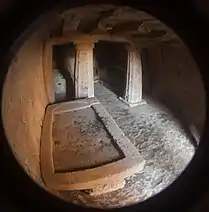
Some large tumulus tombs can be found especially in the Etruscan culture, carved directly into the local limestone (tufa), and covered by a limestone dome and a layer of dirt and grass (see image to the right). From the outside, they resemble burial mounds.
The interior of these tumuli, however, is what makes them so unique. Most tombs have one central corridor, where sarcophagi and urns house the cremated[69] remains of the deceased were found, and the various rooms to either side of the corridor which contain the deceased's various belongings.[70]
Many tombs also hold paintings, or frescos, that in many cases represent the funeral, scenes of real life, or the afterlife. The most significant necropolises with tumulus tombs are Veio, Cerveteri, Vetulonia, and Populonia. The tumulus of Montopoli is relative of archaic center Colli della Città along paratiberina way in Tiber valley.
Smaller barrows are dated to the Villanova period (ninth-eighth centuries BC), but the biggest were used in the following centuries (from the seventh century afterwards) by the Etruscan aristocracy.

Netherlands
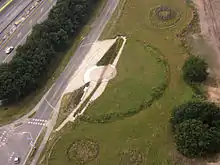
Burial mounds are the most numerous archaeological monuments in the Netherlands. In many places, these prehistoric graves are still clearly visible as low hills. The oldest tumuli (grafheuvels) in the Netherlands were built near Apeldoorn about 5,000 years ago. Concentrations of tumuli from the Bronze Age are located on the Veluwe and Drenthe.
Early scholarly investigation of tumuli and hunebedden and theorising as to their origins was undertaken from the 17th century by notably Johan Picardt. Although many have disappeared over the centuries, some 3000 tumuli are known of which 636 are protected as Rijksmonument.[72] The largest tumulus in the Netherlands is the grave of a king near Oss. Rijksmuseum van Oudheden, Drents Museum, and Huis van Hilde have findings from tumuli in their collections.
Portugal
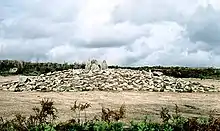
One of the densest manifestations of the megalithic phenomenon in Europe occurred in Portugal. In the north of the country there are more than 1000 late prehistoric barrows. They generally occur in clusters, forming a necropolis. The method of inhumation usually involves a dolmen. The tumuli, dated from c. 4450 to 1900 BC, are up to 3 metres high, with diameters from 6 to 30 metres. Most of them are mounds of earth and stones, but the more recent ones are composed largely or entirely of stones (cairns). In Portuguese, barrows are called mamoas, from the Latin mammulas, given to them by the Romans because of their shape, similar to the breast of a woman.
Scandinavia
Burial mounds were in use from the Stone Age until the 11th century in Scandinavia and figure heavily in Norse paganism. In their original state they usually appear as small, man-made hillocks, though many examples have been damaged by ploughing or plundering so that little visible evidence remains.
The tumuli of Scandinavia is of a great variety of designs, depending on the cultural traditions of the era in which they were constructed. The tumuli tombs may contain single graves, collective graves and both inhumation and cremation was practiced, again depending on the era, but also on geography. Many tumuli in Scandinavia shows a continuation of use from Stone Age to Viking Age. In the Viking Age (and perhaps in earlier times as well) burning the deceased, was believed to transfer the person to Valhalla by the consuming force of fire. Archaeological finds testifies that the cremation fire could reach temperatures of up to 1500 °C. The remains were often covered with cobblestones and then a layer of gravel and sand and finally a thin layer of turf or placed in urns. The tumuli were used for ancestral worshipping, an important practice in Norse culture and many places shows continuation of use for millennia.
Thus he (Odin) established by law that all dead men should be burned, and their belongings laid with them on the pile, and the ashes be cast into the sea or buried in the earth. Thus, said he, every one will come to Valhalla with the riches he had with him upon the pile, and he would also enjoy whatever he himself buried in the earth. For men of consequence a mound should be raised to their memory, and for all other warriors distinguished for manhood, a standing stone. This custom remained long after Odin's time. [...] It was their faith that the higher the smoke arose in the air, the higher he would be raised whose pile it was, and the richer he would be, the more property that was consumed with him.
Sweden

- Anundshög, located just outside the City of Västerås, is Sweden's largest burial mound.
- Gamla Uppsala, The Royal mounds (Swedish: Kungshögarna) is the name for the three large barrows which are located in Gamla Uppsala. According to ancient mythology and folklore, it would be the three gods Thor, Odin and Freyr lying in Kungshögarna or Uppsala högar.
- Gravhög Gårdstånga, situated in Eslöv Municipality, Skåne County, is the site of a Bronze Age burial mound, (Swedish: Gravhög).
- Hågahögen, King Björn's barrow in Håga (Old Norse word: haugr) near Uppsala has a very strong connection with Björn at Haugi.
- Kungshögar, an archaeological site on the Lake Mälaren island of Adelsö in Ekerö Municipality, contains five large burial mounds.
- Skalunda hög in Västergötland, the site of Skalunda Barrow, an historic burial mound.
Norway
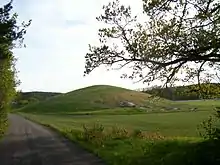
- Raknehaugen, dated to c. 550 AD, is located in the traditional district of Romerike. At 77 m in diameter and a height of 15 m, it is the largest tumulus in Northern Europe.[73]
- Jellhaugen outside Halden, Østfold, considered the 2nd biggest in Norway, and dated back to around 500 AD.
- Gokstadhaugen a burial mound in Sandefjord, Vestfold, revealed a ship burial containing the Gokstad ship, a Viking era ship dating to the 9th century. The ship is the largest in the Viking Ship Museum in Bygdøy, Oslo.
- Oseberghaugen, the Oseberg burial mound at Oseberg near Tønsberg in Vestfold county, contained the Oseberg ship, a well-preserved Viking era ship dating from around 800 AD.
- Borrehaugene (Borre mound cemetery) forms part of the Borre National Park in Horten, Vestfold. The park covers 45 acres (180,000 m2) and its collection of burial mounds includes, seven large mounds and one 25 small cairns.
- Båthaugen, a boat burial mound found at Rolvsøy in Tune, Østfold, contained the Tune ship, a Viking Age ship of the "karv" type. The ship was built around AD 900 and is made of clinkered oak planks.
- Storhaug (Great Mound) ship's burial mound Avaldsnes on Karmøy in Rogaland County, Norway contained a ship made of oak.
- Grønhaug (Green Mound), a ship burial at Avaldsnes, contained an approximately 15-metre (49-foot) long boat with remains of a man's grave from the 10th century.
- Flagghaugen (Flag Hill Mound) at Avaldsnes, one of Norway's richest grave dating from the pre-Viking Period, contained a neck ring of 600 grams (21 ounces)t) of pure gold, weapons, bandoleer mountings and various tubs of silver and bronze.
- Karnilshaugen, in Gloppen in the county of Sogn og Fjordane, is Karnil's tumulus.
- Osneshaugen, in Ulsteinvik in the county of Møre og Romsdal, is a tumulus overlooking the Osnes beach. It is believed to have been sacked, and has not been excavated in modern times. It has been dated to the Bronze Age.
Denmark
Denmark has about 20,000 preserved tumuli, with the oldest being around 5,000 years old. A great number of tumuli in Denmark has been destroyed in the course of history, ploughed down for agricultural fields or used for road or dyke constructions. Tumuli have been protected by law since 1937 and is officially supervised by the Danish Agency for Culture.[75] Examples of tumuli in Denmark are:[76][77][78]
- Yding Skovhøj in Horsens municipality, Jutland is one of Denmark's Bronze Age burial mounds built on the top of the hill.
- Hov Dås in Thisted municipality, North Jutland is one of Denmark's neolithic burial mounds built on the top of the hill.
- Klekkende Høj is a megalithic passage grave constructed in the Stone Age on the island of Møn. It takes its name from the nearby village of Klekkende.
- Lindholm Høje is a major Viking and Iron Age burial site and former settlement, situated to the north of and overlooking the city of Aalborg.
- Grønjægers Høj, meaning "the mound of Green Hunter", dates to the Nordic Bronze Age and is located near Fanefjord Church on the Danish island of Møn.
- Gorm and Thyra's Høje, two huge burial mounds at Jelling.
Canada
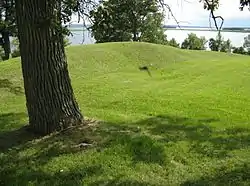
Human settlement in L'Anse Amour dates back at least 7,500 years as evidenced by the burial mound of a Maritime Archaic boy. His body was wrapped in a shroud of bark or hide and placed face down with his head pointed to the west. The site was first excavated in the 1970s.
The Augustine Mound is an important Mi'kmaq burial site in New Brunswick.
Taber Hill is a Haudenosaunee burial mound in Toronto, Ontario.
In the southern regions of Manitoba and Saskatchewan, evidence of ancient mound builders was discovered by archaeologists, beginning with excavations by Henry Youle Hind in 1857.[79][80][81]
In Southwestern British Columbia, several types of burial mounds are known from the Salishan region (Hill-Tout 1895).
United States
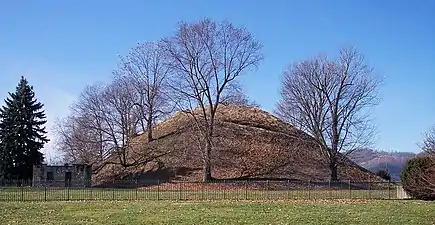
%252C_circa_1876_-_DPLA_-_fd9cf4e1f3cae2a47fea5873b13fd50f.jpg.webp)
Mound building was a central feature of the public architecture of many Native American and Mesoamerican cultures from Chile to Minnesota. Thousands of mounds in the United States have been destroyed as a result of farming, pot-hunting, amateur and professional archaeology, road-building and construction. Surviving mounds are still found in river valleys, especially along the Mississippi, Tennessee and Ohio Rivers, and as far west as Spiro Mounds in Oklahoma.
Mounds were used for burial, to support residential and religious structures, to represent a shared cosmology, and to unite and demarcate community. Common forms include conical mounds, ridge-top mounds, platform mounds, and animal effigy mounds, but there are many variations. Mound building in the USA is believed to date back to at least 3400 BC in the Southeast (see Watson Brake). The Adena and the Mississippian cultures are principally known for their mounds, as is the Hopewell tradition. The largest mound site north of Mexico is Cahokia Mounds, a vast World Heritage Site located just east of St. Louis, Missouri.
Uruguay
The Cerritos de Indios (Spanish for: Indian Mounds or Indian Little Hills) are a collection of more than 3000 tumulus or earth mounds found mainly in the eastern region of Uruguay.
Of different sizes and shapes some of them date back to 5000–4000 years ago being among the oldest examples of tumulus building in the new world. It is still unknown to this day the name or the fate of the people group responsible for its construction as they disappeared long before the arrival of the first European explorers and left no written records.[82]
It is believed that they were used for burial, as well for living and practicing agriculture in the flat marshlands and plains of eastern Uruguay.[83]
See also
- Barrow-downs in Minor places in Middle-earth
- Dolmen
- Pyramids, many of which were tombs, temples, or both
- Stupa
References
- Ratte, Philippe (1993). "The Tomb of Atyattes". Publications de l'Institut Français d'Études Anatoliennes (in French). 3 (1): 1–12.
- Taylor, Richard P. (2000). Death and the Afterlife: A Cultural Encyclopedia. ABC-CLIO. p. 381. ISBN 978-0874369397.
- Fergusson, James. Rubinde Stone Monuments. pp. 31–32.
- Calvert Watkins, American Heritage Dictionary of Indo-European Roots, 2000, p. 92.
- Frederick Klaeber, Attila's and Beowulf's funeral, PMLA (1927); Martin Puhvel, The Ride around Beowulf's Barrow, Folklore (1983).
- Kennedy, Maev (26 October 2016). "Burial mounds make a comeback in 21st-century Britain". The Guardian. ISSN 0261-3077. Retrieved 20 May 2020.
- Middleton, Christopher (13 November 2014). "Stonehenge steward builds his own burial chamber". Telegraph.co.uk. Retrieved 19 August 2017.
- Makey, Julian (23 October 2016). "First burial barrow in thousands of years is completed at Hail Weston". Cambridge-news.co.uk. Retrieved 19 August 2017.
- Wainwright, Oliver (18 March 2019). "Tomb with a view: why burial mounds are a better way to go". The Guardian. ISSN 0261-3077. Retrieved 20 May 2020.
- "Countryfile, Shropshire". BBC One. Retrieved 20 May 2020.
- "Congregation: An exhibition of secular and sacred architecture". London Architecture Diary. Archived from the original on 28 February 2020. Retrieved 20 May 2020.
- Heathcote, Edwin (2 March 2020). "In praise of new sacred buildings". Financial Times. Archived from the original on 10 December 2022. Retrieved 20 May 2020.
- Buxton, Pamela (27 February 2020). "Faith buildings extend inclusivity in changing times". www.ribaj.com. Retrieved 20 May 2020.
- Jones, Ivor (2 September 2017). "'A beautiful place for loved ones to rest': New round barrow to be built at Higher Ground Meadow near Beaminster". Bridport and Lyme Regis News. Retrieved 27 April 2018.
- "Mid-England Barrow – are you looking to store cremation ashes/urns, an alternative to natural burial and funeral venue". Mid-England Barrow – are you looking to store cremation ashes/urns, an alternative to natural burial and funeral venue. Retrieved 20 May 2020.
- Tooley, David (18 May 2020). "'Stone-Age Style' long barrow for people to leave ashes in planned for Milton Keynes". MKFM. Retrieved 20 May 2020.
- "20/0249/FUL | Construction of a neolithic style passage tomb and covering mound | Neolithic Barn Pantmawr Llanidloes Powys". pa.powys.gov.uk. Retrieved 20 May 2020.
- Somali Studies International Association (1992). Charles L. Geshekter; Hussein M. Adam (eds.). The Proceedings of the First International Congress of Somali Studies. Scholars Press. pp. 39–40. ISBN 0-89130-658-7. Retrieved 13 October 2014.
- Proceedings of the Royal Geographical Society of London. Royal Geographical Society of London. 1881. p. 571. Retrieved 18 October 2014.
- Hassan, Fekri (2002). "Palaeoclimate, Food And Culture Change In Africa: An Overview". Droughts, Food and Culture. Springer. pp. 11–26. doi:10.1007/0-306-47547-2_2. ISBN 0-306-46755-0.
- Faraji, Salim (September 2022). "Rediscovering the Links between the Earthen Pyramids of West Africa and Ancient Nubia: Restoring William Leo Hansberry's Vision of Ancient Kush and Sudanic Africa". Journal of Ancient Egyptian Interconnections. 35: 49–67. ISBN 9780964995864. OCLC 1343909954.
- Garcea, Elena A. A. (2013). Gobero The No-return Frontier : Archaeology and Landscape at the Saharo-Sahelian Borderland. Africa Magna Verlag. p. 258. ISBN 9783937248349.
- McDougall, E. Ann (2019). "Saharan Peoples and Societies". Oxford Research Encyclopedia of African History. doi:10.1093/acrefore/9780190277734.013.285. ISBN 978-0-19-027773-4.
{{cite book}}:|website=ignored (help) - Holl, Augustin F.C. (2009). "Coping with uncertainty: Neolithic life in the Dhar Tichitt-Walata, Mauritania, (ca. 4000–2300 BP)". Comptes Rendus Geoscience. 341 (8–9): 703–712. Bibcode:2009CRGeo.341..703H. doi:10.1016/j.crte.2009.04.005.
- MacDonald, K.; Vernet, R. (2007). Early domesticated pearl millet in Dhar Nema (Mauritania): evidence of crop processing waste as ceramic temper. Netherlands: Barkhuis. pp. 71–76. ISBN 9789077922309.
- Kay, Andrea U. (2019). "Diversification, Intensification and Specialization: Changing Land Use in Western Africa from 1800 BC to AD 1500". Journal of World Prehistory. 32 (2): 179–228. doi:10.1007/s10963-019-09131-2. S2CID 134223231.
- Monroe, J. Cameron (2017). ""Elephants for Want of Towns": Archaeological Perspectives on West African Cities and Their Hinterlands". Journal of Archaeological Research. 26 (4): 387. doi:10.1007/s10814-017-9114-2. S2CID 254609731.
- Holl, Augustin F. C. "Megaliths and Cultural Landscape: Archaeology of the Petit Bao Bolon Drainage". Academia.
- Sall, Moustapha. "Academic Research In West Africa: The Case Of Senegal". Academia. Field Manual for African Archaeology.
- Coutros, Peter R. "The Malian Lakes Region redefined:archaeological survey of the Gorbi Valley" (PDF). Cambridge University Press. Antiquity Publications.
- Marot, Laurence Garenne; Mille, Benoît. "Copper-based metal in the Inland Niger delta: metal and technology at the time of the Empire of Mali". ResearchGate. Archetype Publications.
- Random House Unabridged Dictionary (2019). "Kurgan". Dictionary.com. Random House.
- Kipfer, Barbara Ann (2000). Encyclopedic Dictionary of Archaeology. New York: Kluwer Academic/Plenum. p. 291. ISBN 0-306-46158-7.
- Mallory, James P.; Adams, Douglas Q., eds. (1997). Encyclopedia of Indo-European Culture. Fitzroy Dearborn. p. 339. ISBN 1-884964-98-2.
- "Seven cultural sites inscribed on UNESCO's World Heritage List". UNESCO. 6 July 2019.
- Crawford, 2016, Dilmun Temple At Saar.
- Barkay 2003, p. 68.
- Grena 2004, p. 326.
- M. Menon, Srikumar (16 September 2016). "The "Round Mound" and its Structural Requirements: A Possible Scenario for the Evolution of the Form of the Stupa" (PDF). National Institute of Advanced Studies. Retrieved 16 September 2016.
- M. Menon, Srikumar (16 September 2016). "The "Round Mound" and its Structural Requirements: A Possible Scenario for the Evolution of the Form of the Stupa" (PDF). National Institute of Advanced Studies. Retrieved 16 September 2016.
- M. Menon, Srikumar (16 September 2016). "The "Round Mound" and its Structural Requirements: A Possible Scenario for the Evolution of the Form of the Stupa" (PDF). National Institute of Advanced Studies. Retrieved 16 September 2016.
- Singh Bisht, Ravindra. "How the Harappans Honoured Death at Dholavira - Chapter VI. Hemispherical monument or tumulus". Archaeological Survey of India: 271–284. Retrieved 21 March 2011.
- ASI (2007). "Group of Maidams, Charaideo". Archaeological Survey of India, Government of India. Archived from the original on 10 April 2009. Retrieved 30 November 2007.
- 前橋市教育委員会 (29 February 2016). "赤城山南麓の古墳". Comprehensive Database of Archaeological Site Reports in Japan. Retrieved 2 September 2016.
- Nelson, Sarah M. (13 May 1993). The Archaeology of Korea. Cambridge University Press. ISBN 978-0521407830.
- Goran Majetić (9 July 2008). "Tumulusi u Hrvatskoj – veličanstvene prapovijesne "piramide"" (in Croatian). udruga-kameleon.ht. Archived from the original on 13 May 2010. Retrieved 8 October 2010.
- "Picture of "Gödény-halom"". Archived from the original on 11 December 2008.
- A. Puszta (1999). "A Kunhalmok Védelmé és Megmentésük Lehetőségei" [The Possibilities of Protecting and Rescuing Mounds] (PDF). www.nimfea.hu (in Hungarian). pp. 240–287.
- Prof. dr Ljubisa Folic. "Crucified Heritage". kosovo.net. Retrieved 8 October 2010.
- BEd, Herbert KALSER. "Pettendorf > Kulturdenkmäler". Hausleiten (in Austrian German). Retrieved 15 July 2018.
- "Die hallstattzeitlichen Hügelgräber von Langenlebarn, Niederösterreich (FÖMat A 12)" (in German). Retrieved 15 July 2018.
- "Österreichische Nationalbibliothek – Deutsch Altenburg". www.bildarchivaustria.at. Retrieved 15 July 2018.
- Szameit, Erik (1993). "Zu den frühmittelalterlichen Funden aus dem Tumulus I von Bernhardsthal, Niederösterreich" [On the early medieval finds from Tumulus I at Bernhardsthal, Lower Austria] (PDF). museumbernhardsthal.at (in Austrian German). ArchA77/1993. Archived from the original (PDF) on 11 August 2016.
- "Die Hügelgräber – Schandorf". schandorf.at (in Austrian German). Retrieved 15 July 2018.
- Koerbler. "Marktgemeinde Großklein: Die Fürstengräber von Kleinklein". www.grossklein.gv.at (in German). Retrieved 15 July 2018.
- List of Dutch exonyms for places in Belgium
- "Wikimapia - Let's describe the whole world!". wikimapia.org.
- Bougon Tumulus on Megalithic Portal Map Search
- P.-H. Letaudin (1869). Etude historique sur La Cheppe, le camp d'Attila, et ses environs (in French). Le Roy. pp. 5–. Retrieved 27 April 2013.
- Locmariaquer tumuli on Megalithic Portal Map Search
- Nécropole de Champ-Châlons on Megalithic Portal Map Search
- Dissignac tumulus on Megalithic Portal Map Search
- Dolmen Bergerie de Lamalou on Megalithic Portal Map Search
- Bergerie de Panissière on Megalithic Portal Map Search
- Tanouëdou tumulus on Megalithic Portal Map Search
- Péré Tumulus on Megalithic Portal Map Search
- Base Mérimée: PA00091440, Ministère français de la Culture. (in French)
- "Tumulus dit des Hogues". www.pop.culture.gouv.fr.
- Dr. Jeffrey A. Becker, "Sarcophagus of the Spouses (Rome)," in Smarthistory, August 8, 2015, accessed November 3, 2022, https://smarthistory.org/sarcophagus-of-the-spouses-rome/ .
- Fabrizi, Mariabruna (13 September 2015). "The Etruscan Tumuli: Underground Cities for the Dead – SOCKS". socks-studio.com. Retrieved 31 October 2022.
- Cultuurhistorisch Beheer: chbeheer.nl
- Bourgeois, Quentin (2008). "Grafheuvelonderzoek in Nederland: een gedane zaak?" [Burial mound research in the Netherlands: a done deal?]. grafheuvels.nl (in Dutch). Universiteit Leiden. Archived from the original on 21 February 2014. Retrieved 3 February 2014.
- "Raknehaugen, Norway (by Google translate)".
- Inge Adriansen. Nationale symboler i det Danske Rige, 1830–2000, Vol. 2, 2003, p. 123. ISBN 978-87-7289-794-3.
- "Fredede Fortidsminder" (in Danish). Danish Agency for Culture. 28 January 2015. Archived from the original on 21 August 2014. Retrieved 2 September 2015.
- "gravhøj | Gyldendal – Den Store Danske". www.denstoredanske.dk (in Danish). Retrieved 10 December 2017.
- "Tusinder af gravhøje | Gyldendal – Den Store Danske". www.denstoredanske.dk (in Danish). Retrieved 10 December 2017.
- "Professor: Vi risikerer, at gravplyndrere røver hele vores historie". DR (in Danish). Retrieved 10 December 2017.
- (Manitoba History) The Manitoba Mound Builders: The Making of an Archaeological Myth, 1857–1900. Gwen Rempel. 1994. Retrieved 6 February 2017.
- Aboriginal Mounds in Southern Manitoba: An Evaluative Overview. E. Leigh Syms. 1978. Retrieved 6 February 2017.]
- History of Archaeology, Encyclopedia of Saskatchewan. Retrieved 6 February 2017.
- "The Earthen Mounds (Cerritos) of Southern Brazil and Uruguay". Research Gate.
- López Mazz, José M. (September 2001). "Las Estructuras Tumulares (Cerritos) del Litoral Atlantico Uruguayo" [The Tumular Structures (Cerritos) of the Uruguayan Atlantic Coastline] (PDF). Latin American Antiquity (in Spanish). Cambridge University Press. 12 (3): 231–255. doi:10.2307/971631. JSTOR 971631. S2CID 163375789.
Sources
- Albright, William F. (1923). "Interesting finds in tumuli near Jerusalem". Bulletin of the American Schools of Oriental Research. The American Schools of Oriental Research. 10 (April): 1–3. doi:10.2307/1354763. JSTOR 1354763. S2CID 163409706.
- Amiran, Ruth (1958). "The tumuli west of Jerusalem, Survey and Excavations, 1953". Israel Exploration Journal. 8 (4): 205–27.
- Barkay, Gabriel (2003). "Mounds of mystery: where the kings of Judah were lamented". Biblical Archaeology Review. 29 (3): 32–9, 66, 68.
- Grena, G. M. (2004). LMLK – A Mystery Belonging to the King vol. 1. Redondo Beach, California: 4000 Years of Writing History. ISBN 0-9748786-0-X.
- Grinsell, L.V., 1936, The Ancient Burial-mounds of England. London: Methuen.
- Nelson, Sarah Milledge (1993). The Archaeology of Korea. New York: Cambridge University Press.: Cambridge University Press. ISBN 0-521-40783-4.
External links
- . Encyclopædia Britannica (11th ed.). 1911.
- English Heritage Monument Class Descriptions
- The Victorian Barrow Diggers of Wales
- Location Tumuli of Grimde Tienen
- Comprehensive Database of Archaeological Site Reports in Japan
- Heritage Quest, research project using LiDAR data
